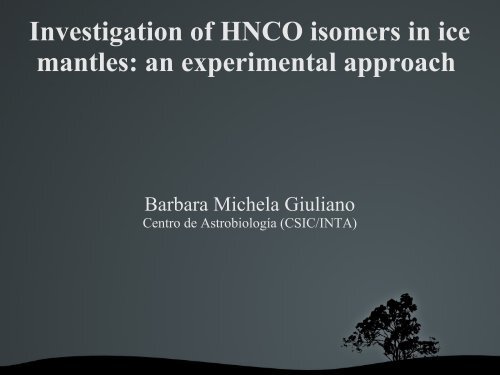Overview: CHNO isomers - Centro de Astrobiología
Overview: CHNO isomers - Centro de Astrobiología
Overview: CHNO isomers - Centro de Astrobiología
Create successful ePaper yourself
Turn your PDF publications into a flip-book with our unique Google optimized e-Paper software.
Investigation of HNCO <strong>isomers</strong> in icemantles: an experimental approachBarbara Michela Giuliano<strong>Centro</strong> <strong>de</strong> <strong>Astrobiología</strong> (CSIC/INTA)
<strong>Overview</strong>: <strong>CHNO</strong> <strong>isomers</strong>Lab. spectroscopiccharacterization:gas-phase from MW to FIR[Brünken et al. 2009 and refstherein]solid-state (matrix isolation)[Teles et al. 1989, Chem. Ber.122, 753 and refs therein]From: Brünken et al. 2009, ApJ, 697, 880.
<strong>Overview</strong>: <strong>CHNO</strong> <strong>isomers</strong>Photochemistry (VUV):gas-phase photodissociation:H+NCO; HN+CO[Okabe 1970, J. Chem. Phys. 53, 3507]matrix isolation isomerization:isocyanic (HNCO) ⇆ cyanic (HOCN)[Milligan & Jacox 1964, J. Chem. Phys. 40, 2457]
<strong>Overview</strong>: <strong>CHNO</strong> <strong>isomers</strong>Astronomy:simplest species which contain the four most importantbiogenic elementsHNCO first <strong>de</strong>tected in the SgrB2 (Sny<strong>de</strong>r & Buhl 1972)and later in many sourcesHOCN tentatively i<strong>de</strong>ntified in SgrB2 (Brünken et al.2009) and four more sources (Marcelino et al. 2010)HCON recently <strong>de</strong>tected in B1, L1544, L193, L1527(Marcelino et al. 2009)No i<strong>de</strong>ntification of HNCO on the interstellar grains(contrary to its anion OCN − )
<strong>Overview</strong>: <strong>CHNO</strong> <strong>isomers</strong>HNCO formation?in the gas phasegas-grain chemistryReaction pathways leading to HNCOisomerization? To explain the presence of higher-lying <strong>isomers</strong> in hotcores and other warm regions.
<strong>Overview</strong>: <strong>CHNO</strong> <strong>isomers</strong>Theule et al. [2011, A&A 530, A96] investigated the HOCNformation from the thermal reaction of HNCO:H 2 O icesFeature of HOCN at ca. 1230 cm -1 is absent.
ExperimentsInvestigation of HNCO formation and possible isomerizationin IS ice analogues by means of vacuum UV irradiation andthermal <strong>de</strong>sorption of different ice mixtures generated in theISAC set-up (UHV chamber) using FTIR spectroscopy andmass spectrometry.UHV chamberMW H 2 -discharge lampICEWINDOW: 8KQuadrupoleMS
Previous experiments:H 2 O:NH 3 :COGrim & Greenberg 1987, ApJ 321, L91 (OCN − );van Broekhuizen et al. 2004, A&A 415, 425 (HNCO).No UHV chamber →Water contamination
H 2 O:NH 3 :COExperiments have been carried out in ISAC on few ML: theHNCO feature (ca. 2260 cm -1 ) is absent.Experiments on thicker ices with simultaneous <strong>de</strong>position andirradition:no efficient production of the HNCO species
H 2 O:HCNGerakines et al. [2004, Icarus 170, 202] observed HNCO andOCN - as products of irradiation and photolysis.Our results for the IR spectra are in agreement with the previousstudies.HNCOOCN −Isomerization???
H 2 O:HCNExperiments on thicker ices: FTIR spectroscopySmall feature which is characteristic of the HOCN isomerHNCOHOCN Vibration Frequency Relative Intensityν CN2286.3 1.00δ COH1221.9 0.92Matrix isolation data, from Teles et al. (1989) Chem. Ber. 122,
H 2 O:HCNData from mass spectrometry:43: Molecular ion(not specific)17: HO fragmentfrom HOCN isomer?Few MLThicker ice
Conclusions and future perspectiveThe formation of the HNCO species in ices mixture ofastrophysical interest has been observedThe efficiency of the process is quite lowIt is very difficult to <strong>de</strong>tect the presence of othertautomeric speciesInvestigation ”in situ” of the gas-solid interface bymeans of laser absorption techniques?
AcknowledgementsPeople:Antonio Jiménez-EscobarGuillermo M. Muñoz CaroJosé CernicharoFunding:Scientific committeefor selecting mycontributionThe audience for thekind attention!CONSOLIDER-INGENIO(ASTROMOL)CSD2009‐00038Place:<strong>Centro</strong> <strong>de</strong> <strong>Astrobiología</strong>(CSIC/INTA)
















